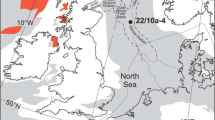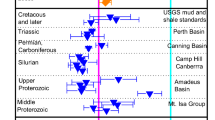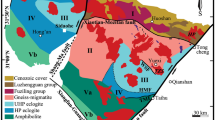Abstract
Hydrogen and oxygen isotope studies have been widely applied to characterize the origin of fluids during ore-forming processes1–4. The primary isotope record, however, may be disturbed by retrograde exchange reactions, thus complicating the interpretation of the data. The susceptibility of minerals to retrograde isotope and chemical exchange is variable5, reflecting differences in the mechanism and rate of isotope exchange. These depend on several factors, including mineralogy, surface area, temperature, pressure, nature and concentration of fluid phase, water/rock ratio. In the Cluff-D uranium deposit within the Athabasca basin (Saskatchewan, Canada) illites and chlorites associated with uranium mineralization are strongly depleted in deuterium (–90 > δD > – 170‰ SMOW (standard mean ocean water)) and have young K/Ar apparent ages (<750 Myr) compared with illites from the barren zones around the ore deposit ( – 48 > δD > –62‰; 1,265 Myr)6–8. Both the δD values and K/Ar 'ages' decrease with increase in the uranium content of the rock. The H2O+ content of illite from mineralized samples is higher than the theoretical value as well as samples from the barren zone. These relationships are interpreted in terms of radiation-catalysed retrograde hydrogen isotope and K–Ar exchange of the clays at low temperatures with post-Cretaceous meteoric waters.
Similar content being viewed by others
References
1. Taylor, H. P. Jr Econ. Geol. 69, 843-883 (1974). 2. Ohmoto, H. Rev. Miner. 16, 491-559 (1986). 3. Sheppard, S. M. F. Rev. Miner. 16, 165-183 (1986). 4. Taylor, B. E. in Stable Isotope Geochemistry of Low Temperature Processes (ed. Kyser, T. K.) 337-445 (Miner. Ass. Canada, 1987). 5. Cole, D. R. & Ohmoto, H. Rev. Miner. 16, 41-90 (1986). 6. Halter, G., Sheppard, S. M. F., Pagel, M. & Weber, F. Terra Cognita 5, 153 (1985). 7. Halter, G., Pagel, M., Sheppard, S. M. F., Weber, F. & Clauer, N. Memoires du BRGM (in the press). 8. Clauer, N., Ey, F. & Gauthier-Lafaye, F. in The Carswell Structure Uranium Deposits, Saskatchewan (eds Laine, R., Alonso, D. & Svab, M.) 47-53 (Spec. Pap. Geol. Ass. Canada, 29, 1985). 9. Pagel, M. & Jaffrezic, H. C.r. hebd. Acad. Seanc. Acad. Sci., Paris 284D, 113-116 (1977). 10. Hoeve, J. & Sibbald, T. I. I. in Symp. Uranium Saskatchewan (ed. Dunn, C. E.) 331-354 (Saskat. Geol. Surv., spec. publ. no. 3, 1976). 11. Ey, F. thesis, Univ. Strasbourg (1984). 12. Hoeve, J., Rawsthorn, K. & Quirt, D. Saskat. Geol. Surv. Misc. Rep. 81-84, 76-89 (1981). 13. Pagel, M. C.r. hebd. Seanc. Acad. Sci., Paris 284D, 113-116 (1975). 14. Pagel, M., Poty, B. & Sheppard, S. M. F. in Uranium in the Pine Creek Geosyncline 639-654 (IAEA, Vienna, 1980). 15. Wallis, R. H., Saracoglu, N., Brummer, J. J. & Golightly, J. P. CIM Bull. 1-28 (1984). 16. Wilson, M. R., Kyser, T. K., Mehnert, H. H. & Hoeve, J. Geochim. cosmochim. Acta 51, 869-878 (1987). 17. Clayton, R. N., Friedman, I., Graf, D. L., Mayeda, T. K. & Shimp, N. F. /. geophys. Res. 71, 3869-3882 (1966). 18. Ey, F., Gauthier-Lafaye, F., Lillie, F., Schumacher, F. & Weber, F. in The Carswell Structure Uranium Deposits, Saskatchewan (eds Laine, R., Alonso, D. & Svab, M.) 121-138 (Spec. Pap. Geol. Ass. Canada, 29, 1985). 19. Bray, C. J. et al. Can. J. Earth Sci. 24, 10-23 (1987). 20. Ruhlmann, F. in The Carswell Structure Uranium Deposits, Saskatchewan (eds Laine, R., Alonso, D. & Svab, M.) 105-120 (Geol. Ass. Canada, spec, paper 29, 105-120, 1985). 21. Schoell, M. Org. Geochem. 6, 645-663 (1984). 22. Cathelineau, M. & Nieva, D. Contrib. miner. Petrol. 91, 235-244 (1985). 23. Paul, H. (ed.) Nuclear Geology 1-414 (Wiley, New York, 1954). 24. Melander, L. Isotope Effects on Reaction Rates 1-181 (Ronald, New York, 1960). 25. Leventhal, J. S. & Threlkeld, C. N. Science 202, 430-432 (1978). 26. Dubessy, J., Beny, J. M., Pagel, M., Poty, B. & Kosztolanyi, C. IMA Meeting, Orleans, Collected Abstracts 129 (1980). 27. Dubessy, J. et al. Geochim. cosmochim. Acta (submitted). 28. Friedman, I. & O'Neil, J. R. in Data of Geochemistry 6th edn, 440-KK (US Govt Printing Office, Washington DC, 1977). 29. Friedman, I., Redfield, A. C., Schoen, B. & Harris, J. Rev. Geophys. 2, 177-224 (1964). 30. Savin, S. & Epstein, S. Geochim. cosmochim. Acta 34, 25-42 (1970). 31. Sheppard, S. M. F., Nielsen, R. L. & Taylor, H. P. Jr Econ. Geoi 64, 755-777 (1969). 32. Lawrence, J. R. & Taylor, H. P. Jr Geochim. cosmochim. Acta 36, 1377-1393 (1972). 33. Sheppard, S. M. F. J. geol. Soc. 133, 573-591 (1977). 34. Clauer, N., O'Neil, J. R. & Bonnot-Courtois, C. Geochim. cosmochim. Acta 46, 1755-1762 (1982).
Author information
Authors and Affiliations
Rights and permissions
About this article
Cite this article
Halter, G., Sheppard, S., Weber, F. et al. Radiation-related retrograde hydrogen isotope and K—Ar exchange in clay minerals. Nature 330, 638–641 (1987). https://doi.org/10.1038/330638a0
Received:
Accepted:
Issue Date:
DOI: https://doi.org/10.1038/330638a0
- Springer Nature Limited





